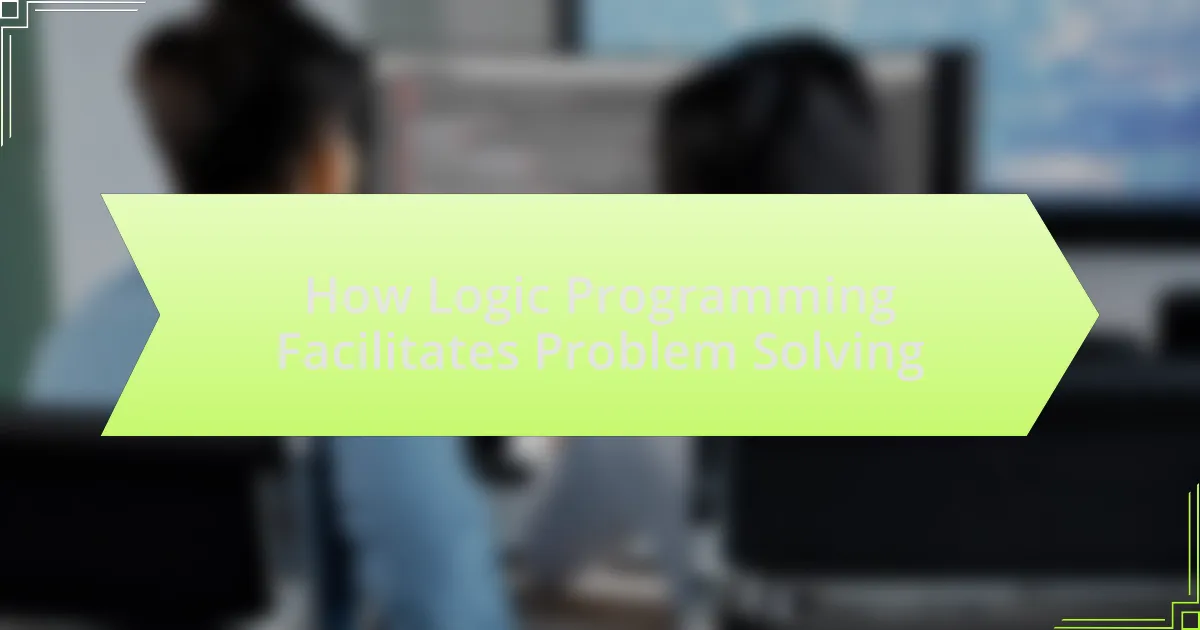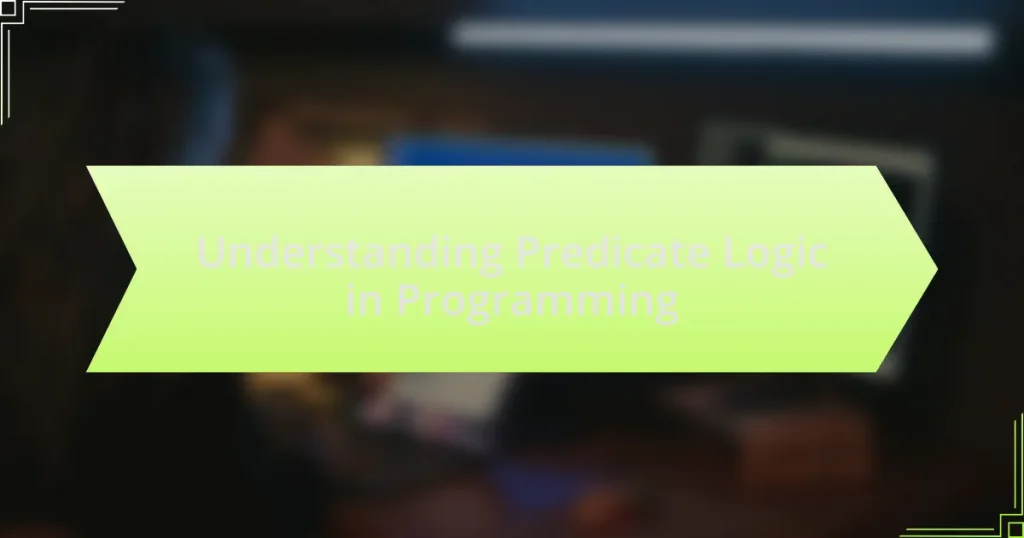Logic programming is a programming paradigm rooted in formal logic, where programs are articulated through relations defined by facts and rules. This approach enhances problem-solving by allowing developers to focus on the desired outcomes rather than the computational processes, facilitating automated reasoning and inference. The article explores the distinctions between logic programming and other paradigms, key principles such as declarative programming and inference mechanisms, and the advantages it offers in various domains like artificial intelligence and natural language processing. Additionally, it addresses the challenges faced by practitioners, including performance issues and limitations in expressiveness, while suggesting best practices and hybrid approaches to improve outcomes in logic programming applications.

What is Logic Programming and How Does it Facilitate Problem Solving?
Logic programming is a programming paradigm based on formal logic, where programs are expressed in terms of relations, represented as facts and rules. This approach facilitates problem solving by allowing developers to specify what the solution should satisfy rather than how to compute it, enabling automated reasoning and inference. For instance, Prolog, a prominent logic programming language, uses a resolution-based mechanism to derive conclusions from given facts and rules, making it particularly effective for tasks such as natural language processing, theorem proving, and knowledge representation. The declarative nature of logic programming allows for clearer problem formulation and easier modifications, as changes to the logic do not require alterations to the underlying control flow, thus enhancing efficiency in problem-solving processes.
How does Logic Programming differ from other programming paradigms?
Logic programming differs from other programming paradigms primarily in its approach to problem-solving, which is based on formal logic rather than procedural or object-oriented methods. In logic programming, such as in Prolog, programs consist of a set of facts and rules that define relationships and constraints, allowing the system to infer conclusions through a process of logical deduction. This contrasts with imperative programming, where the focus is on explicitly defining a sequence of operations to achieve a result, and with object-oriented programming, which centers on encapsulating data and behavior within objects. The declarative nature of logic programming enables developers to express what the solution should accomplish without detailing how to achieve it, facilitating a higher level of abstraction and often leading to more concise and readable code.
What are the key principles of Logic Programming?
The key principles of Logic Programming include declarative programming, the use of facts and rules, and the process of inference. Declarative programming allows programmers to express the logic of a computation without detailing its control flow. In Logic Programming, facts represent known information, while rules define relationships and conditions for deriving new information. Inference is the mechanism through which conclusions are drawn from the given facts and rules, often utilizing techniques like resolution and unification. These principles enable efficient problem-solving by allowing complex problems to be expressed in a clear and logical manner, facilitating automated reasoning and deduction.
How does declarative nature impact problem-solving?
The declarative nature of logic programming significantly enhances problem-solving by allowing users to focus on what the problem is rather than how to solve it. This abstraction enables programmers to express solutions in terms of relationships and constraints, which can lead to more efficient and clearer problem formulation. For instance, in Prolog, a logic programming language, users define facts and rules, and the system automatically determines the best way to satisfy the given conditions, reducing the cognitive load on the programmer. This approach has been validated in various applications, such as artificial intelligence and database querying, where declarative languages have shown to improve both the speed and accuracy of problem-solving processes.
What types of problems can be effectively solved using Logic Programming?
Logic programming effectively solves problems related to knowledge representation, automated reasoning, and constraint satisfaction. It excels in domains such as artificial intelligence, where it can represent complex relationships and rules, enabling systems to infer new information from existing data. For instance, Prolog, a prominent logic programming language, is widely used in natural language processing and expert systems, demonstrating its capability to handle tasks that require logical deduction and rule-based reasoning. Additionally, logic programming is adept at solving combinatorial problems, such as scheduling and resource allocation, by defining constraints and allowing the system to explore possible solutions efficiently.
Which domains benefit most from Logic Programming?
Logic programming benefits most domains such as artificial intelligence, natural language processing, and database management. In artificial intelligence, logic programming enables the development of intelligent agents that can reason and make decisions based on knowledge representation. In natural language processing, it facilitates the parsing and understanding of human languages through formal grammar rules. In database management, logic programming supports query languages like Prolog, allowing for complex data retrieval and manipulation. These domains leverage the declarative nature of logic programming to solve problems efficiently and effectively.
How does Logic Programming handle complex problem structures?
Logic Programming handles complex problem structures by utilizing a declarative approach that focuses on expressing the logic of a problem without specifying control flow. This allows for the representation of intricate relationships and constraints within a problem domain, enabling the solver to derive solutions through inference. For instance, Prolog, a prominent logic programming language, employs facts and rules to represent knowledge, allowing for complex queries to be resolved through backtracking and unification. This method is effective in domains such as artificial intelligence and natural language processing, where problems often involve numerous variables and relationships, demonstrating the capability of logic programming to manage complexity efficiently.
What are the advantages of using Logic Programming for problem-solving?
Logic Programming offers several advantages for problem-solving, including declarative nature, automatic backtracking, and ease of expressing complex relationships. The declarative nature allows users to specify what the problem is rather than how to solve it, simplifying the problem-solving process. Automatic backtracking enables the system to explore multiple potential solutions efficiently, which is particularly useful in constraint satisfaction problems. Additionally, Logic Programming excels in expressing complex relationships through logical rules, making it easier to model real-world scenarios. These features contribute to its effectiveness in various applications, such as artificial intelligence and database querying.
How does it enhance reasoning and inference capabilities?
Logic programming enhances reasoning and inference capabilities by providing a formal framework that allows for the representation of knowledge and the execution of logical deductions. This framework enables systems to derive conclusions from a set of premises through mechanisms such as unification and backtracking. For instance, Prolog, a prominent logic programming language, uses a resolution-based approach to infer new information from existing facts and rules, effectively allowing for complex problem-solving scenarios. The ability to express relationships and constraints in a declarative manner facilitates automated reasoning, making it easier to identify solutions to problems that require logical analysis.
What role does backtracking play in problem-solving?
Backtracking plays a crucial role in problem-solving by systematically exploring potential solutions and eliminating those that fail to meet the criteria of the problem. This method allows for the efficient traversal of solution spaces, particularly in combinatorial problems such as puzzles, optimization tasks, and constraint satisfaction problems. For instance, in the N-Queens problem, backtracking enables the algorithm to place queens on a chessboard while ensuring that no two queens threaten each other, effectively pruning the search space and reducing computational time. The effectiveness of backtracking is evidenced by its application in various algorithms, such as depth-first search, which leverages this technique to find solutions in a structured manner.

How do Logic Programming Languages Support Problem Solving?
Logic programming languages support problem solving by enabling declarative programming, where users specify what the solution should satisfy rather than how to achieve it. This approach allows for the expression of complex relationships and constraints succinctly, facilitating reasoning about problems through logical inference. For example, Prolog, a prominent logic programming language, uses facts and rules to derive conclusions, making it effective for tasks such as natural language processing and knowledge representation. The ability to backtrack and explore multiple potential solutions further enhances problem-solving capabilities, as demonstrated in applications like automated theorem proving and expert systems.
What are the most popular Logic Programming languages?
The most popular Logic Programming languages include Prolog, Mercury, and Datalog. Prolog, developed in the 1970s, is widely recognized for its use in artificial intelligence and computational linguistics, allowing for complex problem-solving through its backtracking and unification mechanisms. Mercury, introduced in the 1990s, enhances Prolog’s capabilities with strong typing and mode systems, making it suitable for large-scale applications. Datalog, a subset of Prolog, is primarily used in database queries and reasoning tasks, emphasizing its efficiency in handling logical queries. These languages are foundational in the field of logic programming, each contributing unique features that facilitate problem-solving in various domains.
How does Prolog facilitate problem-solving tasks?
Prolog facilitates problem-solving tasks through its declarative programming paradigm, which allows users to express logic in terms of relations and rules rather than control flow. This approach enables efficient querying and reasoning about complex problems, as Prolog uses a built-in inference engine to derive conclusions from the provided facts and rules. For instance, Prolog’s backtracking mechanism systematically explores possible solutions, making it particularly effective for tasks such as constraint satisfaction, natural language processing, and knowledge representation. The language’s ability to handle symbolic reasoning and its support for recursive definitions further enhance its problem-solving capabilities, allowing for elegant solutions to intricate logical problems.
What unique features do other Logic Programming languages offer?
Other logic programming languages offer unique features such as constraint logic programming, which allows for the specification of constraints that must be satisfied, enhancing problem-solving capabilities in domains like scheduling and resource allocation. For example, languages like Prolog support backtracking and unification, enabling efficient search through possible solutions. Additionally, languages like Mercury provide strong typing and mode declarations, which improve performance and reliability by allowing the compiler to catch errors at compile time. These features collectively enhance the expressiveness and efficiency of logic programming in solving complex problems.
How do these languages implement logical reasoning?
Logic programming languages implement logical reasoning through the use of formal rules and facts that define relationships and constraints within a problem domain. These languages, such as Prolog, utilize a declarative approach where the programmer specifies what the program should accomplish rather than how to achieve it. This is achieved by defining a set of logical statements, which the language’s inference engine uses to derive conclusions or solve queries based on the provided facts and rules. For instance, Prolog employs a resolution-based inference mechanism that systematically applies logical rules to deduce new information, allowing for complex problem-solving capabilities.
What mechanisms are used for rule definition and querying?
Rule definition and querying in logic programming primarily utilize mechanisms such as Horn clauses and predicate logic. Horn clauses allow for the representation of rules in a structured format, where a rule consists of a head and a body, enabling the inference of conclusions from given premises. Predicate logic enhances this by allowing the expression of relationships and properties of objects, facilitating complex queries. These mechanisms are foundational in systems like Prolog, where rules are defined and queried through a logical inference engine that applies resolution techniques to derive answers from the defined rules.
How do these languages manage knowledge representation?
Logic programming languages manage knowledge representation through formal structures such as facts, rules, and queries. These languages, like Prolog, utilize a declarative approach where knowledge is expressed in terms of relationships and logical statements, allowing for efficient inference and reasoning. For instance, Prolog represents knowledge using predicates that define relationships among entities, enabling the system to derive conclusions based on the provided information. This method of representation supports automated reasoning, as the language’s inference engine can process the rules and facts to answer queries or solve problems, demonstrating the effectiveness of logic programming in knowledge management.

What are the Challenges and Limitations of Logic Programming in Problem Solving?
The challenges and limitations of logic programming in problem solving include issues such as inefficiency in handling large datasets, difficulty in expressing certain types of problems, and limitations in performance due to the inherent complexity of logical inference. Logic programming languages, like Prolog, can struggle with scalability, as the computational resources required for backtracking and searching through possible solutions can grow exponentially with the size of the problem. Additionally, some problems, particularly those involving uncertainty or probabilistic reasoning, are not easily represented in a purely logical framework, which can hinder the applicability of logic programming in real-world scenarios. Furthermore, the declarative nature of logic programming can lead to challenges in optimizing performance, as programmers may have less control over execution strategies compared to imperative programming paradigms.
What common challenges do practitioners face when using Logic Programming?
Practitioners face several common challenges when using Logic Programming, including difficulty in debugging, performance issues, and a steep learning curve. Debugging in Logic Programming can be complex due to the non-procedural nature of the language, making it hard to trace the flow of execution and identify errors. Performance issues arise because certain algorithms may not be optimized for logic-based execution, leading to slower processing times compared to imperative programming languages. Additionally, the steep learning curve is often attributed to the abstract concepts and formal logic required, which can be challenging for those unfamiliar with these principles. These challenges can hinder the effective application of Logic Programming in practical scenarios.
How does performance vary with problem complexity?
Performance typically decreases as problem complexity increases. This is due to the exponential growth of potential solutions and the computational resources required to evaluate them. For instance, in logic programming, as the number of variables and constraints in a problem rises, the time taken to derive solutions can increase significantly, often leading to longer processing times and higher memory usage. Research indicates that algorithms designed for simpler problems can struggle to scale effectively, resulting in diminished performance when applied to more complex scenarios.
What are the limitations in expressiveness and efficiency?
Logic programming exhibits limitations in expressiveness and efficiency primarily due to its reliance on formal rules and constraints, which can restrict the representation of complex real-world scenarios. For instance, while logic programming can effectively model problems with clear logical structures, it struggles with ambiguity and uncertainty, making it less suitable for domains requiring nuanced understanding, such as natural language processing. Additionally, the efficiency of logic programming can be hindered by the computational overhead associated with backtracking and unification processes, which can lead to increased execution time, particularly in large search spaces. Empirical studies, such as those by Apt and Bol, demonstrate that while logic programming is powerful for certain classes of problems, its performance can degrade significantly when faced with more intricate or less structured problem domains.
How can these challenges be addressed?
Challenges in logic programming can be addressed through enhanced training and education, improved tools, and community collaboration. By providing comprehensive training programs for developers, organizations can ensure that individuals possess the necessary skills to effectively utilize logic programming techniques. Additionally, developing user-friendly tools that simplify the implementation of logic programming can reduce barriers to entry and increase adoption rates. Collaborative efforts within the programming community, such as open-source projects and forums, can facilitate knowledge sharing and problem-solving, allowing practitioners to collectively tackle common challenges. These approaches have been shown to improve the efficacy of logic programming in various applications, as evidenced by successful case studies in fields like artificial intelligence and database management.
What best practices can improve Logic Programming outcomes?
To improve Logic Programming outcomes, practitioners should adopt best practices such as modular design, clear predicate definitions, and thorough testing. Modular design enhances maintainability and reusability of code, allowing for easier debugging and updates. Clear predicate definitions ensure that the logic is understandable and reduces ambiguity, which is crucial for effective problem-solving. Thorough testing, including unit tests and integration tests, verifies that the logic behaves as expected and helps identify errors early in the development process. These practices collectively lead to more efficient and reliable Logic Programming solutions.
How can hybrid approaches enhance problem-solving capabilities?
Hybrid approaches enhance problem-solving capabilities by integrating multiple methodologies, such as logic programming and machine learning, to leverage their strengths. This integration allows for more flexible and robust solutions, as logic programming excels in handling complex rule-based reasoning while machine learning provides adaptability through data-driven insights. For instance, a study by Kambhampati et al. (2019) demonstrated that combining these approaches can significantly improve decision-making processes in dynamic environments, leading to more effective outcomes in fields like robotics and automated reasoning.
What practical tips can enhance the effectiveness of Logic Programming in problem-solving?
To enhance the effectiveness of Logic Programming in problem-solving, practitioners should focus on clear problem definition, modular design, and efficient use of built-in predicates. Clear problem definition allows for precise formulation of rules and queries, which is essential for effective logic representation. Modular design promotes code reusability and simplifies debugging, as smaller, self-contained modules can be tested independently. Efficient use of built-in predicates, such as those for list manipulation or arithmetic operations, can significantly reduce the complexity of code and improve performance. These strategies are supported by the fact that structured approaches in programming lead to better maintainability and scalability, as evidenced by studies in software engineering that highlight the importance of modularity and clarity in code development.



